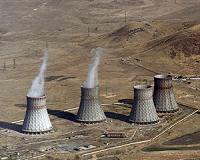 |
Vienna (AFP) March 13, 2011 - Radiation levels at the Onagawa nuclear plant in Japan have returned to normal after a state of emergency was called there earlier, the UN atomic watchdog IAEA said Sunday. "The Japanese authorities have informed the IAEA that radioactivity levels at the site boundary of the Onagawa nuclear power plant have returned to normal background levels," the International Atomic Energy Agency said in a statement. Earlier, excessive levels at Onagawa had led the authorities to report a state of emergency there. "The first or lowest state of emergency was reported at the plant earlier on Sunday after an increased level of radioactivity was detected at the site boundary," the Vienna-based IAEA said. "Investigations at the site indicate that no emissions of radioactivity have occurred from any of the three units at Onagawa. The current assumption of the Japanese authorities is that the increased level may have been due to a release of radioactive material from the Fukushima Daiichi nuclear power plant," it said. The IAEA said it would continue to liaise with the Japanese authorities and was "monitoring the situation as it evolves." IAEA chief Yukiya Amaon is to hold a news briefing about the current situation at Japan's nuclear power plants at the agency's headquarters at 5:30 pm (1630 GMT) on Monday.
Japan radiation unlikely to reach US: officials "Given the thousands of miles between the two countries, Hawaii, Alaska, the US Territories and the US West Coast are not expected to experience any harmful levels of radioactivity," the federal Nuclear Regulatory Commission (NRC) said in a statement. "All the available information indicates weather conditions have taken the small releases from the Fukushima reactors out to sea away from the population," the statement read. The office also said it sent two boiling-water reactor experts as part of a US Agency for International Development (USAID) emergency team helping respond to the crisis in Japan. The NRC is coordinating with the US Department of Energy and other federal agencies in providing "whatever assistance the Japanese government requests" following the March 11 earthquake and tsunami, the statement read. However nuclear expert Joseph Cirincione, speaking on Fox News Sunday, was less optimistic. He said that in a "worst-case scenario" radioactivity would get into the ground, air and water. "Some of the radioactivity could carry in the atmosphere to the West Coast of the United States," said Cirincione, president of the Ploughshares Fund, which advocates for the elimination of nuclear weapons. That scenario is "absolutely" possible, he said, pointing to the Chernobyl meltdown in Ukraine in 1986, when "the radioactivity spread around the entire Northern Hemisphere. It depends how many of these cores melt down and how successful they are on containing it once the disaster happens." Japan on Sunday struggled to contain a possible meltdown of two reactors at a quake-hit nuclear plant. An explosion at the aging Fukushima No. 1 atomic plant blew apart the building housing one of its reactors Saturday, one day after the biggest quake ever recorded in Japan unleashed a monster tsunami. The emergency escalated Sunday as crews struggled to prevent overheating at a second reactor where the cooling system has also failed, and the government warned that it could also be hit with a blast.
Share This Article With Planet Earth
Related Links - Nuclear Power News - Nuclear Science, Nuclear Technology Powering The World in the 21st Century at Energy-Daily.com
 Nuclear contamination: The options
Nuclear contamination: The optionsParis (AFP) March 13, 2011 Evacuation, temporary shelter and iodine pills are the chief weapons for protecting civilians against nuclear fallout, experts say. A blast on Saturday that wrecked the concrete shell surrounding the No. 1 reactor at Japan's Fukushima nuclear plant released radioactive vapour but not at levels dangerous for human health, according to Japanese officials. Specialists say the authorities ha ... read more |
|
| The content herein, unless otherwise known to be public domain, are Copyright 1995-2010 - SpaceDaily. AFP and UPI Wire Stories are copyright Agence France-Presse and United Press International. ESA Portal Reports are copyright European Space Agency. All NASA sourced material is public domain. Additional copyrights may apply in whole or part to other bona fide parties. Advertising does not imply endorsement,agreement or approval of any opinions, statements or information provided by SpaceDaily on any Web page published or hosted by SpaceDaily. Privacy Statement |